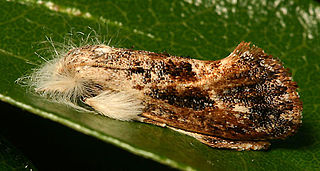
Moths are a paraphyletic group of insects that includes all members of the order Lepidoptera that are not butterflies, with moths making up the vast majority of the order. There are thought to be approximately 160,000 species of moth, many of which have yet to be described. Most species of moth are nocturnal, but there are also crepuscular and diurnal species.

The Sphingidae are a family of moths (Lepidoptera) called sphinx moths, also colloquially known as hawk moths, with many of their caterpillars known as “hornworms”; it includes about 1,450 species. It is best represented in the tropics, but species are found in every region. They are moderate to large in size and are distinguished among moths for their agile and sustained flying ability, similar enough to that of hummingbirds as to be reliably mistaken for them. Their narrow wings and streamlined abdomens are adaptations for rapid flight. The family was named by French zoologist Pierre André Latreille in 1802.

The Arctiinae are a large and diverse subfamily of moths with around 11,000 species found all over the world, including 6,000 neotropical species. This subfamily includes the groups commonly known as tiger moths, which usually have bright colours, footmen, which are usually much drabber, lichen moths, and wasp moths. Many species have "hairy" caterpillars that are popularly known as woolly bears or woolly worms. The scientific name Arctiinae refers to this hairiness. Some species within the Arctiinae have the word "tussock"' in their common names because they have been misidentified as members of the Lymantriinae subfamily based on the characteristics of the larvae.

Oecophoridae is a family of small moths in the superfamily Gelechioidea. The phylogeny and systematics of gelechoid moths are still not fully resolved, and the circumscription of the Oecophoridae is strongly affected by this.

The Gelechiidae are a family of moths commonly referred to as twirler moths or gelechiid moths. They are the namesake family of the huge and little-studied superfamily Gelechioidea, and the family's taxonomy has been subject to considerable dispute. These are generally very small moths with narrow, fringed wings. The larvae of most species feed internally on various parts of their host plants, sometimes causing galls. Douglas-fir (Pseudotsuga) is a host plant common to many species of the family, particularly of the genus Chionodes, which as a result is more diverse in North America than usual for Gelechioidea.

The Crambidae are the grass moth family of lepidopterans. They are variable in appearance, the nominal subfamily Crambinae taking up closely folded postures on grass stems where they are inconspicuous, while other subfamilies include brightly coloured and patterned insects which rest in wing-spread attitudes.

Notodontidae is a family of moths with approximately 3,800 known species. The family was described by James Francis Stephens in 1829. Moths of this family are found in all parts of the world, but they are most concentrated in tropical areas, especially in the New World.

The Pyraloidea are a moth superfamily containing about 16,000 described species worldwide, and probably at least as many more remain to be described. They are generally fairly small moths, and as such, they have been traditionally associated with the paraphyletic Microlepidoptera.

Acrolophidae is a family of moths in the order Lepidoptera. The family comprises the burrowing webworm moths and tube moths. The family holds about 300 species in five genera, which occur in the wild only in the New World. It is closely related to the Tineidae family.
Prototheora is a genus of moths. It is the only genus of the Prototheoridae, or the African primitive ghost moths, a family of insects in the lepidopteran order, contained in the superfamily Hepialoidea. These moths are endemic to Southern Africa.

The Erebidae are a family of moths in the superfamily Noctuoidea. The family is among the largest families of moths by species count and contains a wide variety of well-known macromoth groups. The family includes the underwings (Catocala); litter moths (Herminiinae); tiger, lichen, and wasp moths (Arctiinae); tussock moths (Lymantriinae), including the arctic woolly bear moth ; piercing moths ; micronoctuoid moths (Micronoctuini); snout moths (Hypeninae); and zales, though many of these common names can also refer to moths outside the Erebidae. Some of the erebid moths are called owlets.
Prototheora parachlora is a species of moth of the family Prototheoridae. It is found in South Africa, where it is only known from the Karkloof Forest region of KwaZulu-Natal.
Prototheora corvifera is a species of moth of the family Prototheoridae. It is found in South Africa, where it is known only from the top of Table Mountain. The rocky surface of this sandstone mesa is predominantly covered by a low, bushy vegetation generally referred to as mountain fynbos.
Prototheora petrosema is a moth species of the family Prototheoridae. It is found in Western Cape and Eastern Cape provinces of South Africa. It lives in the predominantly fynbos cape vegetation of the temperate Knysna Forest. It has been found frequently around the lower slopes of Table Mountain in Cape Town.
Prototheora quadricornis is a species of moth of the family Prototheoridae. It is found in South Africa.
Prototheora merga is a species of moth of the family Prototheoridae. It is found in South Africa, where it is only known from the Schoemanspoort in the Cape Province.
Prototheora biserrata is a species of moth of the family Prototheoridae. It is found in South Africa, where it known from only one and possibly two localities in the southern Cape Province. The holotype was collected in the wet, temperate Groenkop forest near George. A second specimen, possibly the female of the same species, was found at Camps Bay, a coastal fynbos habitat immediately south of Cape Town.
Prototheora angolae is a species of moth of the family Prototheoridae. It is found in Angola, where it known only from the type locality which is located in central Angola.

Autostichidae is a family of moths in the moth superfamily Gelechioidea.










